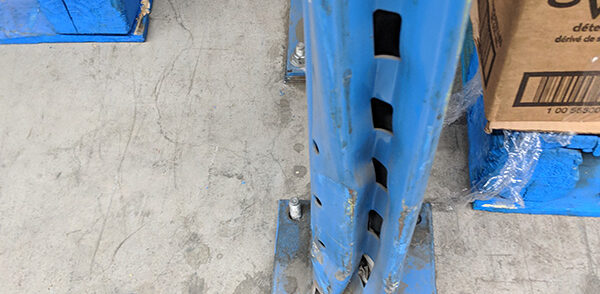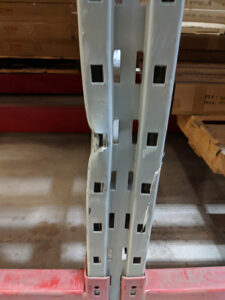Pre-Start Health & Safety Review (PSR) – What You Should Know
What is the purpose of a Pre-Start Health & Safety Review (PSR)
A Pre-Start Health & Safety Review (PSR) is mandatory document that provides a professional review of pallet racking systems, equipment and work flow processes in the storage facility. This insures that potential work place hazards are removed or controlled before workers are exposed.
Section 7, Table 1 refers to clause 45 (b) of OHSA and states that when material, articles or products are stored on a structure that is a rack or stacking structure, will require a Pre-Start Health & Safety Review (PSR) or equivalent documentation from the manufacturer.
Employer’s Responsibility
By Law, the employer or lessee is responsible to provide a safe work place and to insure that a professional has provided a Pre-Start Health & Safety Review (PSR) or equivalent documentation, showing the pallet racking structure is in compliance with the relevant sections of OHSA Section 7.
Federal Law, Bill C45, in short says that an individual, in the undertaking to direct how another person does work (i.e.: supervisor, manager, owner) contravenes his or her duty to take reasonable steps to prevent bodily harm, and show wanton or reckless disregard for the lives or safety of others may be charge with Criminal Negligence, i.e.: if you are aware of any racking that is considered to be unsafe (does not meet the design standards) and you do not have it inspected, repaired to the code of standards or replaced and someone is injured due to a rack failure, you will be charged with Criminal Negligence and most likely go to jail and have a criminal record along with a hefty fine.
When is a Pre-Start Health & Safety Review (PSR) Required
A Pre-Start Health & Safety Review (PSR) is required whenever a new, used or modified structure, piece of equipment or process is constructed, added or installed into the workplace. In the case of Steel Pallet Racking, if the racking is used, if existing racking has been disassembled and then reassembled, if beam heights have been changed or if the racking has been repaired, it will require a Pre-Start Health & Safety Review (PSR). An engineer or the manufacturer should be consulted for acceptable repair methods before any repairs are made.
Who can conduct a Pre-Start Health & Safety Review (PSR)
A Pre-Start Health & Safety Review (PSR) is to be conducted by a Professional with expert knowledge of racking and an engineer (P. Eng.), who has received a Certificate of Authorization from the Professional Engineers Ontario organization (PEO) certifying that he/she is competent to perform such work for the public and that he/she has Personal Liability Insurance as required by the Professional Engineering Act.
What is included in the Pre-Start Health & Safety Review (PSR) report
A Pre-Start Health & Safety Review (PSR) report for steel pallet racking must be dated and signed by the reviewer and include details of the measures required to insure the racking is in compliance with the relevant provisions listed under Section 7 of OHSA. A study of beam loading conditions is done and the maximum allowable beam and skid load is provided. The loading conditions apply only to racking frames and beams that are compliant with the appropriate storage rack design and installation codes. A professional engineer must affix his or her seal to the report.
How should records be kept
Pre-Start Health & Safety Review (PSR) reports shall be kept readily accessible in the workplace together with any supporting documentation and be provided to the joint health and safety committee or health and safety representative before the apparatus, structure or process is put in use.
Who must have access to the report
The Pre-Start Health & Safety Review (PSR) report and documentation may be reviewed, on request, a Ministry of Labour inspector or by the company’s joint health and safety committee or health and safety representative.
Storage pallet rack code requirements for damaged racks
Damage to a rack frame or beam will reduce its load capacity. The greater the damage, the greater the reduction in the load carrying capacity. Damage to the frame bracing will reduce the capacity of the frame to withstand accidental impact to the front post and will also reduce the axial load carrying capacity of the frame. Damage to the beam/frame connection will reduce the load capacity of the beam.
There are two main Safety Codes that apply to the design, installation and maintenance of steel storage rack structures.
(a) Rack Manufacturer’s Institute (RMI) – Specification for the design, testing and utilization of industrial steel storage racks.
(b) SEMA Code of Practice for the design of static racking
The RMI Code states that “Upon any visible damage, the pertinent portions of the rack shall be unloaded immediately by the user and the damaged portion shall be adequately repaired or replaced”.
The SEMA specification allows for measurable amount of damage and provides a method of measuring the damage.
For damage to frames and bracing members:
- Any frame with a tear, split, buckle or bend should be replaced.
- A frame with a bend in the direction of the rack beam should be measured using straight edge 1.0 meters long. Placed against the concave edge, the gap between the edge and the rack at the bend should not exceed 5.00mm.
- For a frame bent in the plane of the frame bracing the maximum gap between the frame and the straight edge should not exceed 3.00mm.
- For a frame with damage in both directions deformation should be measured as above and the appropriate limits maintained.
- For bracing members bent in either plane the gap between the straight edge and the member should not exceed 10mm.
If the damage exceeds any of these tolerances the damaged member should be replaced or repaired. Any repairs to a rack frame must be done according to the manufacturer’s specifications or by a method approved by an engineer.
For damage to beams:
- Beams showing signs of cracks in the welds between the end connector and the beam section should be replaced.
- Beams with end connectors showing deformation should be unloaded and the supplier consulted.
- Beams will naturally deflect under normal loading to a maximum vertical deformation not to exceed the measure of the beam length in inches divided by 180 (L”/180). This deflection should disappear when the beam is unloaded. With the load removed, the maximum vertical deformation should not exceed 20% of the normal deflection while under load. The lateral deformation should not exceed 40 % of the normal vertical deflection under load.
If the damage exceeds any of these tolerances the damaged beam should be replaced. Damaged beams should not be repaired.

